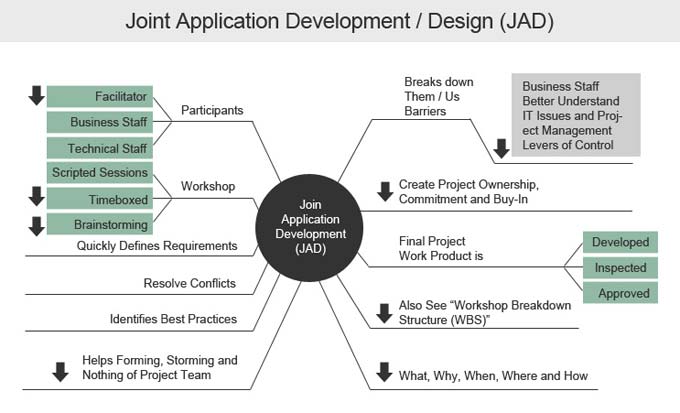Table of Contents
In this article you’ll learn about Joint Application Development (JAD), Participants in a JAD , Phases of JAD as well Benefits and drawbacks of Joint Application Development
What is JAD ?
JAD stands for Joint Application Development. It is an information gathering technique that allows the projects teams, users and management to work together to identify requirements for the system. JAD techniques is often the most useful method for collecting information from users.
According to Caphers Jones, “JAD can reduce scope creep by 50%, and it avoids the requirement for a system from being too specific or too vague, both of which cause trouble during later stages of the SDLC”.

JAD is structured process in which 10 to 20 users meet under the direction of a facilitator skilled in JAD techniques. JAD groups meets for several hours, several days, several weeks until of the issues have been discussed and needed information is collected. Most JAD sessions take place in a specially prepared meeting rooms, away from the participants officers ,so that they are not interrupted.
Participants in a JAD
The typical participants in a JAD are listed below:
- JAD session leader: The JAD leader organizes and runs the JAD. This person is trained in group management and facilitation as well as system analysis. The JAD leader sets the agenda and sees that it is met. The JAD leader remains neutral on issues and does not contribute ideas or opinions but rather concentrates on keeping the group on the agenda, resolving conflicts and disagreements, and soliciting all ideas.
- Users: The key users of the system under consideration are vital participants in a JAD. They are the only ones who have a clear understanding of what it means to use the system on a daily basis.
- Managers: The role of managers during JAD is to approve project objectives, establish project priorities, approve schedules and costs and approve identified training needs and implementation plans.
- Sponsors: A JAD must be sponsored by someone at a relatively high level in the company i.e. the person from top management. If the sponsor attends any session, it is usually at the very beginning or at the end.
- Systems Analysts: Members of the systems analysis team attend the JAD session although their actual participation may be limited. Analysts are there to learn from customers and managers, but not to run or dominate the process.
- Scribe: The scribe takes down the notes during the JAD sessions. This is usually done on a personal computer or a laptop. Notes may be taken using a word processor. Diagrams may directly be entered into a CASE tool.
- IS staff :Like systems analysts, other IS staff such as programmers, database analysts, IS planners and data center personnel may attend to learn from the discussions and possibly to contribute their ideas on the technical feasibility of proposed ideas or on technical limitations of current systems.
Phases Of JAD
The generic phases of the JAD life cycle include:
1. Define objectives
In this phase, the facilitator articulates the meeting agenda and outcomes and shares them with the participants for review.
2. Session preparation
This phase involves the facilitator researching the session objectives to get a holistic insight and prepare the session’s logistics.
3. Session conduct
The JAD session is conducted in this phase, and the progress is reviewed. Prototypes can be presented in the sessions to resolve conflicts among the stakeholders.
4. Documentation
In this phase, the requirements or design documents are compiled and reviewed.
Benefits of Joint Application Development
The following are the various benefits of Joint Application Development:
- Actively involves users and management in project development,
- Reduces the amount of time required to develop a system, and
- Incorporates prototyping as a means for confirming requirements and obtaining design approvals.
Drawbacks of JAD
Since there are varying stakeholders involved in JAD, conflicts are inevitable, and it often takes multiple JAD meetings to reach an agreement. Moreover, JAD sessions demand significant time from all stakeholders, which can be difficult.
Is JAD a SDLC?
JAD is a model for software development that augments the stakeholders’ association in cycles of software development. Its life cycle has been adopted for areas of the dynamic software development method.
Thank you for reading, If you have reached so far, please like the article, It will encourage me to write more such articles. Do share your valuable suggestions, I appreciate your honest feedback!